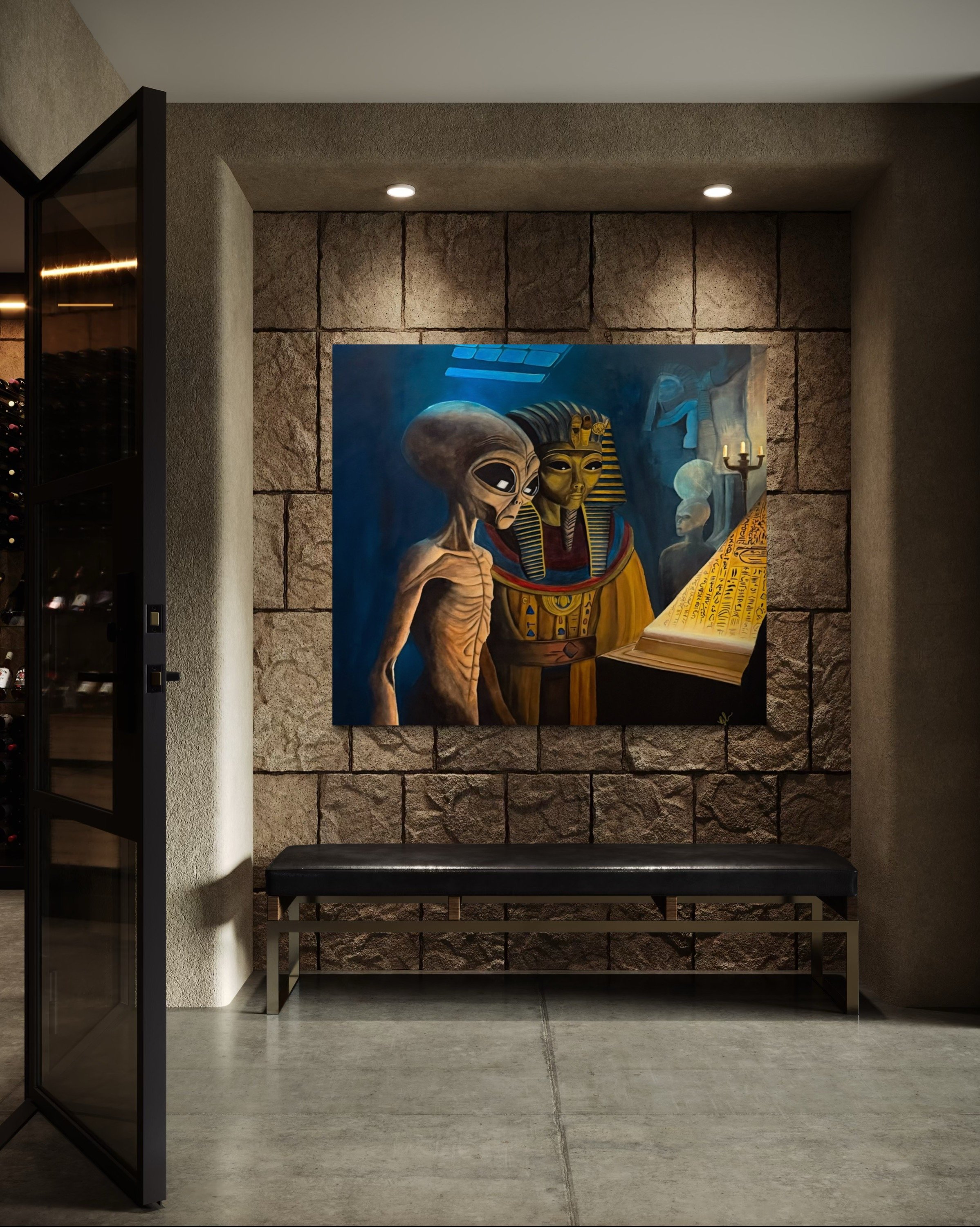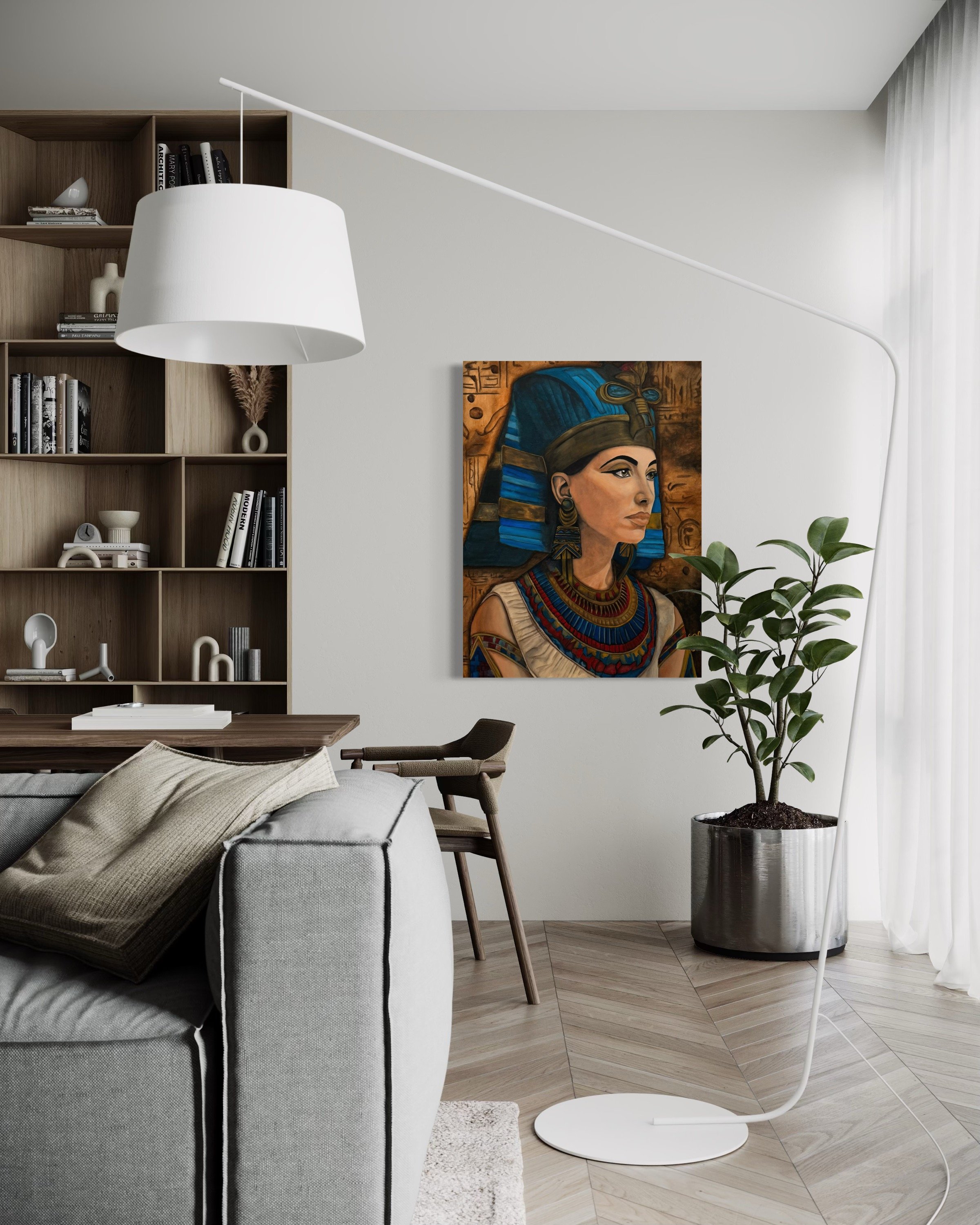The story of Tutankhamun is one of the most fascinating tales from ancient Egypt. He was a young pharaoh who ruled during the 18th dynasty around 1332 to 1323 B. C. Tutankhamun became famous not just for his reign but also for the treasures found in his tomb. His burial site discovered in 1922 by Howard Carter was filled with gold jewelry and many other valuable items. This discovery captured the world's imagination and sparked a renewed interest in ancient Egypt.
When I decided to paint Tutankhamun I wanted to create something unique and thought-provoking. I chose to pair him with an alien figure. This combination might seem strange at first but I believe it reflects the timeless curiosity about life beyond our planet. Just as ancient Egyptians looked to the heavens for guidance many people today wonder about extraterrestrial life. By merging these two themes I aimed to create a dialogue between the past and the future.
In my artwork Tutankhamun symbolizes the rich history of human civilization while the alien represents the unknown. Together they tell a story of exploration and discovery. The pharaoh’s golden mask is a reminder of human achievement and culture. Meanwhile the alien serves as a metaphor for our endless quest for knowledge and understanding of the universe.
The colors and shapes in my painting also play an important role in conveying this message. I chose vibrant colors to represent the energy and life of ancient Egypt. The alien with its otherworldly features contrasts sharply with the familiar image of the pharaoh. This contrast emphasizes the differences between our world and the imagined universe beyond it. It invites viewers to consider how history and the future can intersect in unexpected ways.
In conclusion my decision to paint Tutankhamun alongside an alien is not just about art; it is about exploring deeper ideas. It reflects my belief that history and imagination can come together to inspire new thoughts. By looking at the past through a modern lens we can find new meaning in ancient stories. This painting is an invitation for viewers to think about their own place in the universe and the endless possibilities that lie ahead.
Cleopatra is one of the most fascinating figures in history. She was the last active ruler of the Ptolemaic Kingdom of Egypt. Known for her intelligence charm and political skills Cleopatra played a crucial role in the history of Egypt and Rome. Her life was filled with drama power struggles and romance making her a captivating subject for art.
I decided to paint Cleopatra on canvas because her story inspires many people. She was not just a beautiful queen; she was also a strong leader. Cleopatra fought for her country's independence and tried to protect her people from powerful enemies. By capturing her image on canvas I want to honor her legacy and share her remarkable journey with others.
Using acrylic paints allows me to express Cleopatra's vibrant personality. Acrylics dry quickly and can create bold colors which suit the richness of her story. I envision deep blues and golds to represent Egypt's beauty and wealth. Each stroke of paint will bring her character to life adding depth and emotion to the artwork.
As I paint I think about Cleopatra's relationships with figures like Julius Caesar and Mark Antony. These alliances helped her maintain her power but also led to her downfall. This complexity adds layers to my artwork reflecting both her strength and vulnerability. I hope viewers will see not just a queen but a woman who faced immense challenges.
In conclusion painting Cleopatra is a way for me to connect with history and share a powerful story. Her life teaches us about leadership love and the fight for what one believes in. Through my painting I aim to capture her spirit and inspire others to learn more about her. Cleopatra's legacy continues to resonate making her an eternal figure in art and history.
Cleopatra was one of the most famous queens in history. She ruled Egypt during a time of great change and conflict. Born in 69 BC she belonged to the Ptolemaic dynasty which was of Greek origin. Cleopatra was known for her intelligence and strong leadership skills. She spoke several languages and was educated in various subjects making her a well-rounded ruler.
When Cleopatra became queen Egypt was facing many challenges. The country was struggling with internal problems and external threats. Julius Caesar the Roman leader came to Egypt during this time. Cleopatra saw an opportunity to form an alliance with him. This partnership helped her regain power and stabilize her kingdom.
After Caesar's assassination Cleopatra returned to Egypt but soon faced another challenge. She met Mark Antony a Roman general and the two formed a powerful bond. Their relationship was both romantic and political as they sought to strengthen their positions against their enemies. Together they fought to maintain control over Egypt and expand their influence.
However their alliance led to conflict with Rome. Octavian Caesar's adopted son viewed Cleopatra and Antony as threats. This rivalry culminated in a famous battle at Actium in 31 BC. Cleopatra and Antony were defeated which marked the beginning of the end for their reign.
Eventually Cleopatra's situation became desperate. With Octavian closing in she took her own life in 30 BC. Her death marked the end of the Ptolemaic dynasty and the beginning of Roman rule in Egypt. Cleopatra's legacy lives on as she is remembered not only for her beauty but also for her intelligence and determination as a leader.



